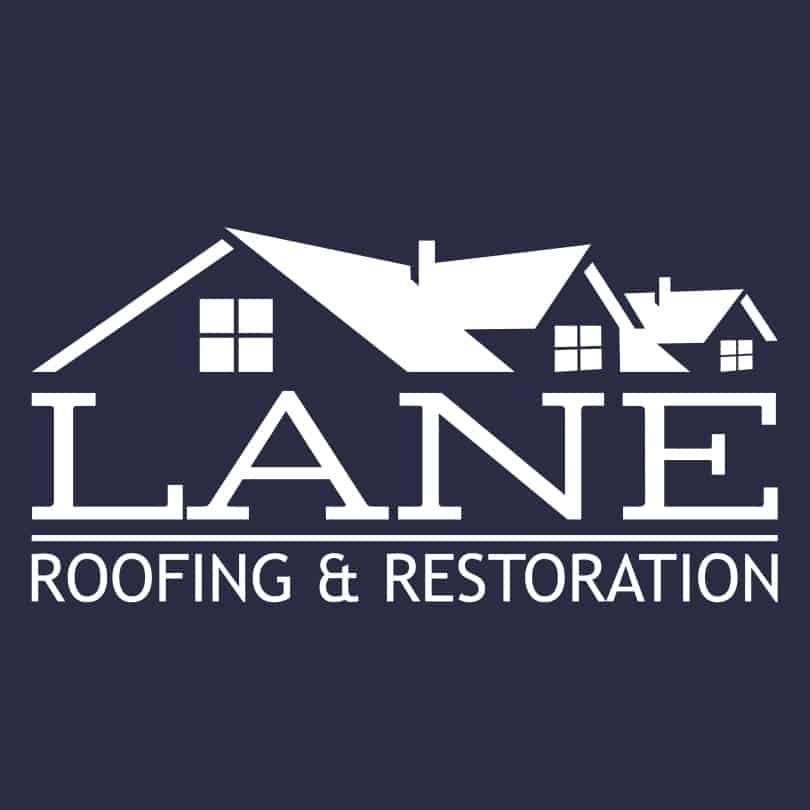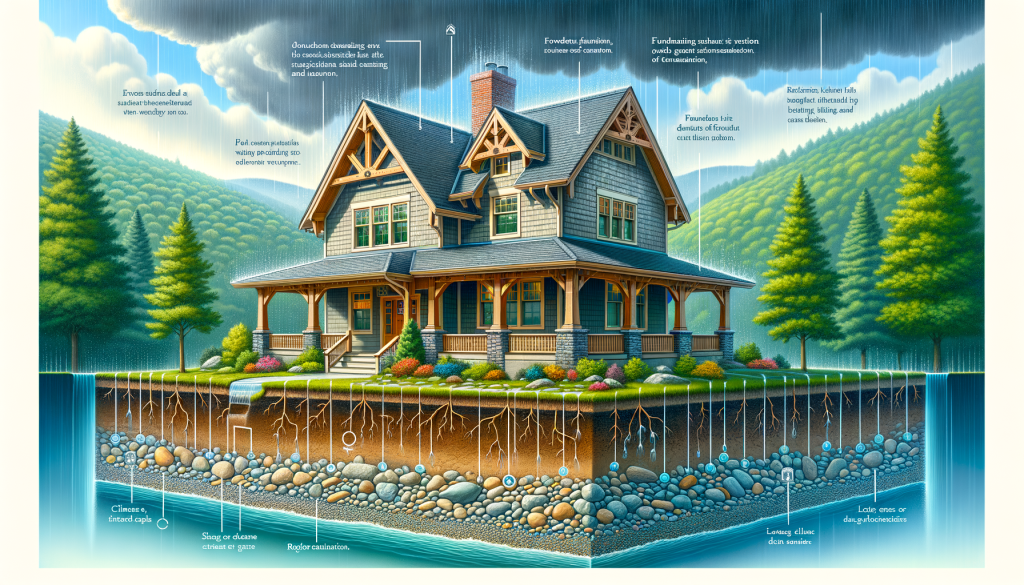When most Asheville homeowners think about protecting their property, roof integrity is often top of mind. But there’s a critical connection that many overlook—the relationship between your roof’s drainage system and your home’s foundation. Here in Western North Carolina, where we experience everything from heavy mountain downpours to winter freeze-thaw cycles, proper roof drainage isn’t just a good idea—it’s essential for maintaining your home’s structural integrity.
As we navigate the unique weather patterns of the Blue Ridge Mountains, we at Lane Roofing and Restoration have seen firsthand how inadequate roof drainage can lead to serious foundation issues. The combination of our region’s clay-heavy soils, sloped properties, and seasonal precipitation patterns creates the perfect storm for foundation damage when roof drainage is neglected.
The Critical Connection: Your Roof and Foundation
Your roof and foundation may seem like completely separate parts of your home, but they’re intimately connected through one crucial element: water management. Every inch of rain that falls on your roof needs somewhere to go, and how that water is directed away from your home can make all the difference in foundation health.
In Asheville’s mountainous terrain, where many homes are built on slopes or in valleys, this connection becomes even more important. Water naturally follows the path of least resistance—and without proper controls, that path often leads directly to your foundation.
The primary purpose of any drainage system is to collect water from your roof and direct it away from your home’s foundation. When functioning correctly, gutters capture runoff, downspouts channel it downward, and extensions or splash blocks ensure water is deposited at a safe distance from your foundation.
Common Drainage Problems in Asheville Homes
The unique geography and climate of Western North Carolina present specific challenges for roof drainage systems. After years of serving local homeowners, we’ve identified several recurring issues:
Clogged or inadequate gutters: Our abundant trees mean gutters frequently fill with leaves, pine needles, and debris. When gutters can’t properly channel water, it spills over the sides and pools around your foundation.
Disconnected or damaged downspouts: Heavy storms can dislodge downspout connections or cause damage that prevents water from being properly directed away from the home.
Insufficient downspout extensions: Many homes lack proper extensions to carry water far enough away from the foundation—a particular problem on sloped properties where water can quickly find its way back to the foundation.
Improper grading: The natural slope of your yard should direct water away from your foundation. Many Asheville properties, however, have challenging terrain that works against this principle.
Erosion channels: Over time, concentrated water flow from downspouts can create erosion channels that actually guide water toward your foundation rather than away from it.
How Poor Drainage Damages Your Foundation
When water isn’t properly directed away from your home, several damaging processes begin to unfold:
Hydrostatic pressure: Water-saturated soil creates tremendous pressure against foundation walls, potentially causing cracks and structural movement. This pressure is particularly problematic in our clay-rich mountain soils, which expand significantly when wet.
Soil erosion: Concentrated water flow can wash away soil that supports your foundation, creating voids and allowing for settlement.
Frost heave: During Asheville’s winter months, water-saturated soil near your foundation can freeze and expand, exerting upward pressure that can lift and crack concrete.
Basement or crawl space moisture: Many homes in our region have basements or crawl spaces that are particularly vulnerable to moisture intrusion when drainage is poor. This can lead to mold growth, wood rot, and poor indoor air quality.
The signs of foundation damage from poor drainage often appear gradually. You might notice small cracks in walls or concrete, doors and windows that stick, sloping floors, or persistent dampness in lower levels of your home. While these issues might seem minor at first, they typically indicate more significant structural problems developing beneath the surface.
Creating an Effective Drainage System for Asheville Homes
Fortunately, most drainage-related foundation issues can be prevented with proper attention to your roof’s water management system. Here’s what an effective system should include:
Appropriately sized gutters: In Western North Carolina, where heavy rainfalls are common, larger 6-inch gutters may be necessary to handle the volume of water shed by your roof. Homes surrounded by trees might benefit from gutter guards to prevent clogging.
Strategically placed downspouts: Downspouts should be placed at corners and at intervals along longer roof lines. For most homes, downspouts every 20-40 feet are ideal.
Adequate downspout extensions: Water should be deposited at least 5-6 feet away from your foundation—potentially more on sloped properties. Flexible or hinged extensions can make lawn maintenance easier while still providing protection.
Proper grading: The ground should slope away from your foundation at a rate of about one inch per foot for at least the first 6-10 feet around your home. This can be challenging on mountain lots, but is essential for proper drainage.
Underground drainage solutions: For properties with significant drainage challenges, underground drain pipes or French drains may be necessary to direct water safely away from the foundation.
Seasonal Maintenance for Roof Drainage in Asheville’s Climate
Our distinct seasonal weather patterns in Western North Carolina require regular maintenance of your drainage system:
Spring preparation: Clear gutters of accumulated winter debris before spring rains arrive. Check that downspouts are firmly attached and extensions are properly positioned after winter freezes.
Summer monitoring: After heavy thunderstorms, observe how water flows around your property. Look for areas where water pools near the foundation or where erosion is occurring.
Fall maintenance: Clean gutters frequently as leaves fall. This is perhaps the most critical time for gutter maintenance in our heavily wooded region.
Winter preparation: Ensure downspouts are secure before winter weather arrives. In areas prone to freezing, consider heating elements for gutters and downspouts to prevent ice dams.
At Lane Roofing, we’ve found that many homeowners only discover drainage issues during roof replacement or repair. Our team always evaluates the entire roof system, including drainage components, as part of our comprehensive approach. This allows us to identify and address potential problems before they cause expensive foundation damage.
The Cost Equation: Prevention vs. Repair
When weighing the investment in proper roof drainage, consider the alternative. Foundation repairs in the Asheville area typically start at several thousand dollars and can easily reach $10,000-$30,000 for more severe issues. By contrast, maintaining and improving your drainage system might cost just a few hundred to a couple thousand dollars.
Beyond the financial considerations, foundation problems can compromise your home’s structural integrity, reduce its value, complicate future sales, and create ongoing moisture issues that affect indoor air quality and comfort.
The math is clear—preventive measures are far more economical than remedial repairs. Investing in proper drainage now can save significant expense and headache down the road.
Professional Assessment and Solutions
For many Asheville homes, especially those built on challenging terrain, professional assessment is valuable for developing an effective drainage strategy. When evaluating your property, experienced professionals will consider:
Roof size and configuration: The square footage and complexity of your roof determine how much water must be managed.
Local rainfall patterns: Different areas within Western North Carolina experience varying precipitation levels, with some receiving significantly more rainfall than others.
Property topography: The natural slope and soil composition of your property greatly influence drainage requirements.
Existing drainage issues: Signs of current problems help identify the most critical areas for improvement.
A thorough assessment can reveal issues that aren’t immediately obvious but could cause significant problems over time. Professional solutions might range from simple gutter upgrades to comprehensive drainage systems designed specifically for your property’s unique challenges.
Real-World Example: A Local Success Story
Last year, we worked with homeowners in the Kenilworth neighborhood who had noticed small cracks developing in their basement walls. Their home, built on a gentle slope, was experiencing foundation strain due to improper roof drainage.
After a comprehensive assessment, our team installed larger gutters, additional downspouts, and underground drainage pipes that carried water safely away from the home and toward a nearby natural drainage area. The solution was tailored to both their specific home design and the unique topography of their property.
The result? No further foundation issues, a dry basement, and peace of mind during heavy rains. The investment in proper drainage proved far less costly than the foundation repairs they would have eventually needed.
Moving Forward with Better Protection
Proper roof drainage is one of the most cost-effective ways to protect your home’s foundation. As we often tell our Asheville customers, “Your roof’s job isn’t done until the water reaches the ground—safely away from your foundation.”
For homeowners concerned about their current drainage system, we recommend starting with a simple assessment during the next rainfall. Observe how water flows from your roof and around your property. Look for these warning signs:
– Water overflowing or spilling from gutters
– Downspouts depositing water too close to the foundation
– Areas where water pools near your home
– Eroded soil or mulch
– Basement or crawl space dampness after rain
If you notice any of these issues, it’s worth addressing them promptly before they lead to more significant problems. Remember that in our unique Asheville climate, with its heavy rains and freeze-thaw cycles, foundation protection begins with proper roof drainage.
By understanding and maintaining this crucial connection between your roof and foundation, you’re not just protecting your home—you’re preserving one of your most significant investments for years to come.

